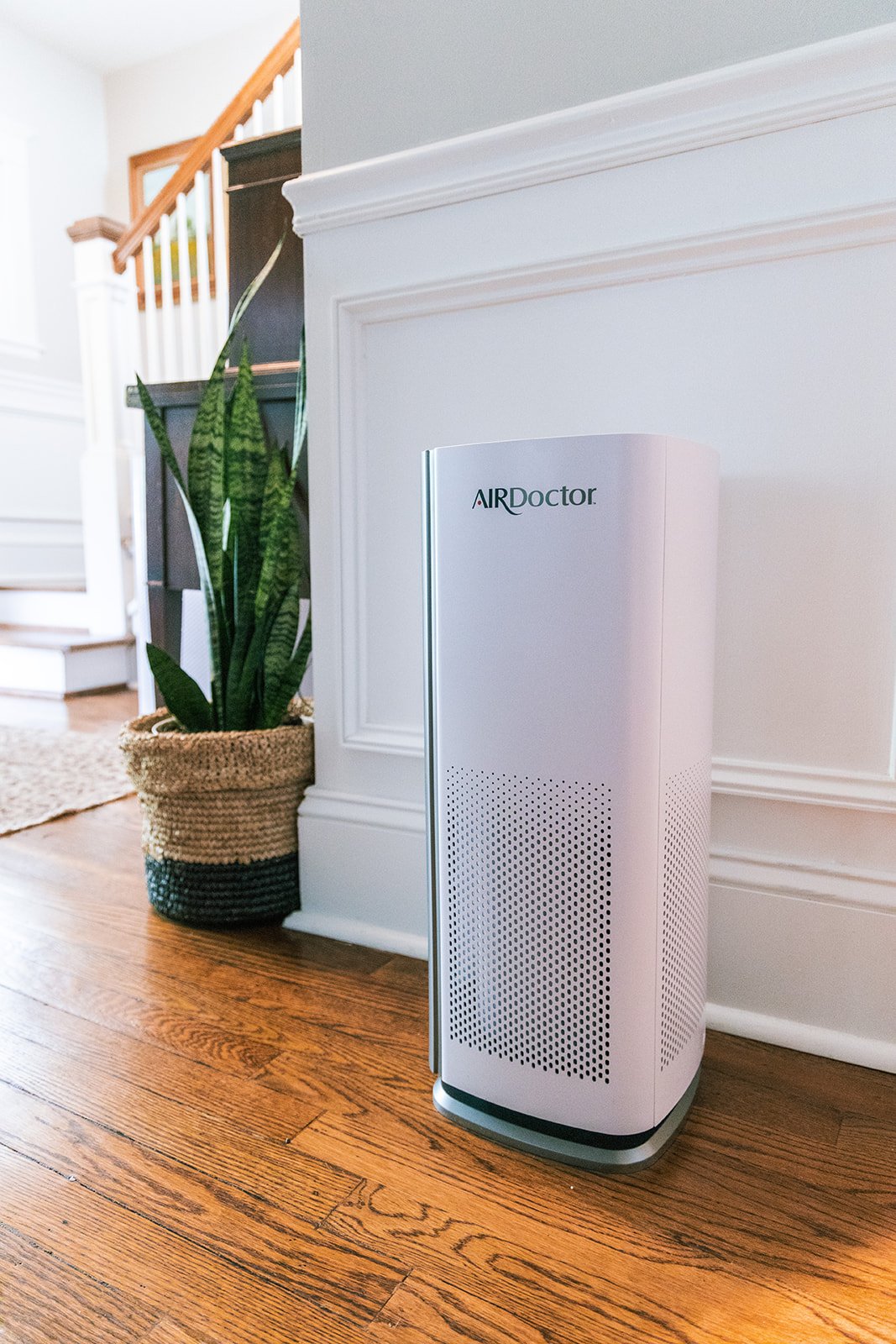You’ve heard all about air purifiers, but what are they and why are they important? The world of “clean air” can be overwhelming. I’m answering all these questions for you so you know why it matters, how to improve the air in your home, and what to look for in an air purifier!
Can Air Purifiers improve your health?
Did you know that indoor air can be 2-5 times more polluted than outdoor air, according to the EPA? From dust mites taking refuge in your pillows to volatile organic compounds (VOCs) sneaking out of your paint cans, these invisible invaders can compromise your health and wellbeing. This guide will empower you with knowledge and practical solutions to improve your indoor air quality.
The Air We Breathe Indoors – Alarming Statistics
Indoor air quality is an often overlooked aspect of our health. Studies have shown that poor indoor air quality is linked to significant health problems, including respiratory conditions and long-term diseases (World Health Organization). Considering we spend roughly 90% of our time indoors, the quality of the air we breathe is paramount for our health and well-being.
Common Pollutants in Our Homes
Indoor air is a complex mix of particles and gases that can have significant health impacts. Here’s what could be lurking in your home:
- Dust Mites and Pet Dander: These allergens can trigger asthma attacks and allergic reactions. They thrive in upholstered furniture, bedding, and carpeting.
- Mold Spores: Mold grows in damp environments and can produce allergens and irritants that affect health.
- Pollen: Entering through open windows and doors, pollen can aggravate allergies.
- Volatile Organic Compounds (VOCs): Emitted from paints, cleaning supplies, and even air fresheners, VOCs can cause eye, nose, and throat irritation, headaches, and more serious health effects.
- Smoke: Whether from tobacco products or wildfires, smoke particles can penetrate deep into the lungs, posing health risks.
- Viruses and Bacteria: These microscopic organisms can circulate through our homes, potentially leading to illness.
Free and Simple Ways to Improve Indoor Air Quality
Improving your home’s air quality doesn’t have to be a costly affair. Here are four actionable steps you can take today:
- Ventilate: Regularly opening your windows facilitates the exchange of your indoor air with fresh, outdoor air, diluting indoor pollutants.
- Houseplants: Incorporate air-purifying plants such as spider plants and snake plants into your home decor. They’re not just aesthetic; NASA’s Clean Air Study found that they can help remove common pollutants (NASA Clean Air Study).
- Regular Cleaning: Use a vacuum (like this one) with a HEPA filter to capture dust mites and pet dander. Regularly washing bedding and textiles can also minimize pollutants.
- Avoid Synthetic Fragrances: Opt for natural fragrances from essential oils instead of synthetic air fresheners, which can emit VOCs into your home environment.
While these simple measures are a great start, for more comprehensive air quality improvement, the addition of an air purifier can be highly effective.
Can Air Purifiers Improve Your Health? What the EPA Says
The EPA has examined studies showing that air purifiers can reduce pollutants indoors and contribute to health benefits such as reducing allergy and asthma symptoms, improving respiratory health, enhancing sleep quality, and reducing harmful chemicals.
Air purifiers should be part of a comprehensive approach to improve indoor air quality, including source control and ventilation improvements (EPA’s Guide to Air Cleaners in the Home).
Understanding Air Purifiers: Your Allies for Cleaner Air
Before we dive into the specifics, let’s understand what an air purifier is and how it functions. An air purifier is a device designed to remove contaminants from the air in a room, improving indoor air quality. These devices are particularly beneficial for individuals with allergies, asthma, and other respiratory conditions, as well as anyone looking to reduce or eliminate harmful particles from their indoor environment.
How Do Air Purifiers Work?
Air purifiers typically use a system of internal fans to pull the air in your home through a series of filters that remove harmful airborne particles like dust, pollen, and bacteria. The clean air is then recirculated back into the room. Here’s a closer look at the components:
- Pre-filters: Capture large particles like hair and dust.
- HEPA filters: High Efficiency Particulate Air (HEPA) filters capture up to 99.97% of particles as small as 0.3 microns, including pollen, dust mites, and pet dander.
- Activated Carbon Filters: Absorb odors and gases, effectively removing them from the air.
- UV Lights: Some models use UV light to kill bacteria and viruses, offering an extra layer of protection.
By combining these technologies, air purifiers can significantly reduce the level of pollutants in your indoor environment, making the air safer and more comfortable to breathe.
Navigating Air Purifier Brands: What Sets Them Apart?
When you step into the world of air purifiers, the variety can be overwhelming. Each brand promises clean air, but how they deliver on this promise can vary significantly. Here’s what sets them apart and what you should look for to find the perfect match for your air-purifying needs.
Key Differentiators Among Brands
- Filtration Technology: The most critical aspect that differentiates air purifiers is their filtration technology. While most brands offer HEPA filters, the efficiency (such as True HEPA, HEPA-Type) and additional filtration systems (like activated carbon filters for odors and UV lights for germs) can vary.
- Clean Air Delivery Rate (CADR): CADR measures the volume of clean air that an air purifier produces at its highest speed setting. Higher CADR ratings indicate more efficient air purification.
- Noise Level: Since air purifiers are often used in living spaces and bedrooms, the noise level can be a deciding factor. Brands vary in their technology to minimize noise while maximizing air purification.
- Smart Features: Some brands offer smart features like air quality sensors, automatic adjustments based on air quality, and remote control via apps. These features enhance usability and effectiveness.
- Price and Operating Costs: Initial price points can vary widely, as can the cost of replacement filters and energy usage. Considering the total cost of ownership is essential.
What to Look for When Choosing an Air Purifier
- Room Size Compatibility: Ensure the air purifier is rated for the size of the room where you plan to use it. An undersized purifier won’t effectively clean the air, while an oversized unit could consume unnecessary power.
- Filtration Needs: Assess your primary needs (allergen removal, odor neutralization, germ disinfection) and select a purifier designed to address those concerns.
- Filter Replacement Frequency and Cost: Understand how often filters need to be replaced and the associated cost to maintain optimal performance.
- Energy Efficiency: Look for ENERGY STAR® certified models to ensure energy efficiency, especially if you plan to run your air purifier continuously.
- Certifications: Certifications like AHAM Verified (for CADR ratings and room size recommendations) and the ENERGY STAR® rating can help validate an air purifier’s performance claims.
The Ultimate Solution for Pure Indoor Air
When it comes to selecting an air purifier, the Air Doctor stands out for its efficacy and advanced technology. With its UltraHEPA™ Filter, it captures particles as small as 0.003 microns—far beyond the capabilities of standard HEPA filters.

Its Dual Action Carbon/Gas Trap/VOC Filter effectively removes gases and odors, making it an unparalleled ally in your quest for a cleaner, healthier home.
Investing in an air purifier like Air Doctor can be a significant step towards safeguarding your health and enhancing your living environment. By adopting simple air-cleaning practices and considering the use of an air purifier, you’re investing in your well-being and ensuring a healthier future for you and your loved ones. Embrace these changes today, for a breath of fresh air tomorrow.


